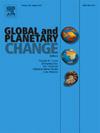瑞典晚寒武世至中奥陶世Alum和Tøyen页岩的Re-Os地质年代和地球化学演化
IF 4
1区 地球科学
Q1 GEOGRAPHY, PHYSICAL
引用次数: 0
摘要
在寒武纪和奥陶纪 100 Myr 的跨度内,准确和精确的放射性年龄数量有限,这妨碍了对这些时期的阶段界线进行可靠的年龄测定。在这里,我们通过提供精确的 Re-Os 时间戳,填补了早古生代年代地层学的重大空白。样品的选择与建立在三叶虫、爬行动物和锥齿动物外观和分布基础上的坚实生物地层框架相关联。在斯泰普图恩正碳同位素激增(SPICE)开始时的一个芙龙纪(上寒武纪)矾土页岩剖面(瑞典斯堪尼亚 Andrarum-3 号钻探岩芯),从一个δ13Corg 波动剧烈的剖面中获得了高度非等时的 Re-Os 同位素数据;然而,从具有稳定碳同位素地层的窄沉积带选取的数据则提供了不精确的 Re-Os 年龄,即 497 ± 28 Ma (2σ; 模型 3; n = 3),初始 187Os/188Os 比率 (Osi) 为 0.74 ± 0.05.来自寒武纪-奥陶纪边界下 120 厘米的富含有机质的矾页岩(Tomten-1 号钻探岩芯,瑞典韦斯特哥特兰)的模型 1 年龄为 488.6 ± 5.1 Ma (2σ; MSWD = 1.5; n = 25),第 10 阶段,即最上寒武纪的 Osi 为 0.82 ± 0.04。生物地层学数据表明,标有年代的矾页岩来自略低于寒武纪顶部(TOCE)、略高于美洲姬蛙(Lotagnostus americanus)首次出现基准(FAD)的区间。富含有机质的 Tøyen 页岩(瑞典斯堪尼亚 Lerhamn 钻探岩芯)得出的第一模型 Re-Os 精确年龄为 469.7 ± 1.4 Ma (2σ; MSWD = 1.0; n = 10),Osi 为 0.802 ± 0.002,为 Floian-Dapingian 阶段边界(下奥陶世-中奥陶世边界)的最大年龄。从最晚的埃迪卡拉纪到寒武纪再到早-中奥陶纪,海水的 Os 同位素组成在 0.8 左右徘徊,但到志留纪早期则下降到 0.54。海水 187Os/188Os 的大幅下降与中奥陶纪晚期化学风化的减少和海水温度的降低是一致的。总体而言,氧化还原敏感元素(RSE;Re、Os、Mo、U)丰度与总有机碳(TOC)呈正相关,表明这些元素被有机物从缺氧水体中有效地去除。然而,这些关系在高 TOC(>10%)页岩沉积于厄休斯条件下时被打破。RSE-TOC关系的破裂支持了水体中金属汲取量的增加以及黄铁矿的局部积累。地球化学数据表明,阿伦页岩和托延页岩是在水文条件受限的环境下沉积的,在晚寒武世至早中奥陶世期间,波罗的海边缘的初级生产力不断提高。本文章由计算机程序翻译,如有差异,请以英文原文为准。
Re-Os geochronology and geochemical evolution of late Cambrian to Middle Ordovician Alum and Tøyen shales, Sweden
The limited number of accurate and precise radiometric ages through the ∼100 Myr span of the Cambrian and Ordovician impedes reliable age determinations for stage boundaries in these periods. Here, we fill significant gaps in the early Paleozoic chronostratigraphy by providing precise Re-Os time-pins. Sample selection is linked to a firm biostratigraphic framework built on the appearance and distribution of trilobites, graptolites, and conodonts. A Furongian (upper Cambrian) Alum Shale section (Andrarum-3 drill core, Scania, Sweden) at the onset of the Steptoean Positive Carbon Isotopic Excursion (SPICE) yields highly non-isochronous Re-Os isotopic data from a section with wildly fluctuating δ13Corg; however, selected data from a narrow sediment band with steady carbon isotope stratigraphy provides an imprecise Re-Os age of 497 ± 28 Ma (2σ; Model 3; n = 3), with an initial 187Os/188Os ratio (Osi) of 0.74 ± 0.05. Organic-rich Alum Shale (Tomten-1 drill core, Västergötland, Sweden) from ∼120 cm below the Cambrian-Ordovician boundary yields a Model 1 age of 488.6 ± 5.1 Ma (2σ; MSWD = 1.5; n = 25) and an Osi of 0.82 ± 0.04 for Stage 10, uppermost Cambrian. Biostratigraphic data indicate the dated Alum Shale is from an interval slightly below the Top Of Cambrian Excursion (TOCE) and slightly above the First Appearance Datum (FAD) of the agnostoid Lotagnostus americanus. Organic-rich Tøyen Shale (Lerhamn drill core, Scania, Sweden) yields a precise Model 1 Re-Os age of 469.7 ± 1.4 Ma (2σ; MSWD = 1.0; n = 10) and Osi of 0.802 ± 0.002 for the maximum age of the Floian–Dapingian stage boundary (Lower–Middle Ordovician boundary). The Os isotopic composition of seawater from the latest Ediacaran through the Cambrian to Early-Middle Ordovician hovers around 0.8 but falls to 0.54 by early Silurian. This significant decrease in seawater 187Os/188Os is consistent with reduced chemical weathering and cooler seawater temperatures through the Middle–Late Ordovician. Overall, Redox Sensitive Element (RSE; Re, Os, Mo, U) abundances correlate positively with Total Organic Carbon (TOC), suggesting efficient removal of these elements from an anoxic water column by organic matter. However, these relationships break down for high TOC (>10%) shales depositing under euxinic conditions. The RSE-TOC relationship breakdown supports enhanced metal drawdown from the water column with local pyrite accumulation. Geochemical data suggest the deposition of Alum and Tøyen shales under hydrographically restricted settings with increased primary productivity along the Baltica's margin during the latest Cambrian to Early-Middle Ordovician.
求助全文
通过发布文献求助,成功后即可免费获取论文全文。
去求助
来源期刊

Global and Planetary Change
地学天文-地球科学综合
CiteScore
7.40
自引率
10.30%
发文量
226
审稿时长
63 days
期刊介绍:
The objective of the journal Global and Planetary Change is to provide a multi-disciplinary overview of the processes taking place in the Earth System and involved in planetary change over time. The journal focuses on records of the past and current state of the earth system, and future scenarios , and their link to global environmental change. Regional or process-oriented studies are welcome if they discuss global implications. Topics include, but are not limited to, changes in the dynamics and composition of the atmosphere, oceans and cryosphere, as well as climate change, sea level variation, observations/modelling of Earth processes from deep to (near-)surface and their coupling, global ecology, biogeography and the resilience/thresholds in ecosystems.
Key criteria for the consideration of manuscripts are (a) the relevance for the global scientific community and/or (b) the wider implications for global scale problems, preferably combined with (c) having a significance beyond a single discipline. A clear focus on key processes associated with planetary scale change is strongly encouraged.
Manuscripts can be submitted as either research contributions or as a review article. Every effort should be made towards the presentation of research outcomes in an understandable way for a broad readership.
 求助内容:
求助内容: 应助结果提醒方式:
应助结果提醒方式:


